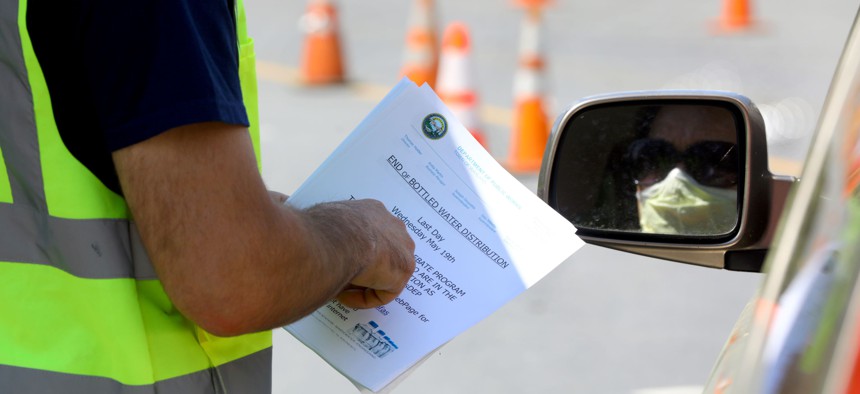EPA issues first-ever drinking water standards for ‘forever chemicals’

Because of the elevated levels of PFAS found in its public water sources, Wayland is distributing bottled water to the public. Water treatment plant manager Nick Iarussi tells a resident about the change to a rebate program in Wayland, MA on May 16, 2021. Pat Greenhouse/The Boston Globe via Getty Images
The Biden administration also announced nearly $1 billion in newly available funding to help public water utilities implement PFAS testing and treatment.
Updated at 2:45 p.m. on April 10, 2024.
Amara Strande died of cancer about a year ago this month. She was just 20 years old, but had become an activist in her short life after being diagnosed with a rare form of liver cancer five years earlier. The cancer, which eventually spread to her throat and lungs, was attributed to her exposure to a group of toxic chemicals known as PFAS.
Just weeks after her death and after at least five appearances before the Minnesota Legislature, lawmakers passed “Amara’s Law,” banning the use of PFAS in the state. Yesterday, on a call with reporters, senior Biden administration officials remembered Strande as they announced the first-ever national and legally enforceable drinking water standard for per-and polyfluoroalkyl substances.
“The first national drinking water standards for PFAS marks a significant step towards delivering on the Biden-Harris administration’s commitment to advancing environmental justice, protecting communities and securing clean water for people across the country,” said Brenda Mallory, chair of the White House Council on Environmental Quality, in a statement.
These so-called forever chemicals are used in a wide variety of products like nonstick cookware, waterproof outdoor gear, makeup, food packaging, and stain-resistant clothing and carpets. The substances seep into soil and water via landfills, hazardous waste sites and even firefighting foam. Called forever chemicals because they break down so slowly, PFAS build up in humans and animals and have been linked to increased risk for some cancers, immune system deficiencies and decreased fertility.
In issuing the national standard, the Environmental Protection Agency says the new rule will reduce PFAS exposure for approximately 100 million people, prevent thousands of deaths and reduce tens of thousands of serious illnesses. But while city and county water districts around the country agree that something must be done, they are worried the new rule will cost them billions of dollars.
To allay these concerns, the Biden administration announced nearly $1 billion in newly available funding through the infrastructure law to help states implement PFAS testing and treatment at public water systems.
But when the rule was initially proposed in March of last year, the National Association of Clean Water Agencies, which represents 350 public wastewater and stormwater agencies nationwide, and other groups said in a fact sheet that the requirement would cost more than $3.5 billion annually to treat and dispose of the chemicals. That figure is well above EPA’s estimate that it will cost between $772 million to $1.2 billion.
That’s in part because the problem is so big. So much of the chemicals have infiltrated U.S. water supplies, that according to a study by the U.S. Geological Survey, at least 45% of the nation’s tap water has one or more types of PFAS in it.
Under the new rule, which sets limits for five kinds of forever chemicals in drinking water, public water utilities will have three years to complete their sampling for the regulated substances. If PFAS is found at levels that exceed the set standards, the utilities will be required to notify the public and implement solutions to reduce PFAS in their drinking water within five years.
The EPA estimates that the new rule will affect between about 6% and 10% of the 66,000 public drinking water systems.
Senior administration officials on the call with reporters yesterday did not give details on how the $1 billion will be distributed, except to say that it will be awarded as grants to the states through the Drinking Water State Revolving Fund program. The newly available funding is part of the $9 billion allocated through the infrastructure law to help communities with PFAS pollution in their drinking water.
When asked about the association of clean water agencies and other groups’ differing cost estimates to clean up PFAs chemicals, senior administration officials responded by emphasizing the $9 billion in the infrastructure law and the additional $12 billion allocated for general drinking water improvements, which can be used to address emerging contaminants like PFAS.
What’s more, officials indicated that there is a “range of available technologies” already in use that could be eligible for grants. The Cape Fear Public Utility Authority in Wilmington, North Carolina, for example, has effectively deployed a granular activated carbon system to remove PFAS. And the Tampa Water Department, for example, is testing innovative water filtration technology called suspended ion exchange that could help boost the efficiency of the PFAS removal process.
Officials also encouraged small, rural and disadvantaged communities to take advantage of the EPA’s Water Technical Assistance program, which will work directly with a water system to identify water challenges like PFAS, develop plans, build capacity and apply for the grants.
But concerns about the cost persist. In a statement, U.S. Sen. Shelley Moore Capito of West Virginia, a member of the Environment and Public Works Committee, worried the new rule would "unfairly burden our local communities."
"Unfortunately," she said, "the standard set today by the administration [...] takes the wrong approach, which will result in increased costs for local water systems and ultimately, ratepayers.”





